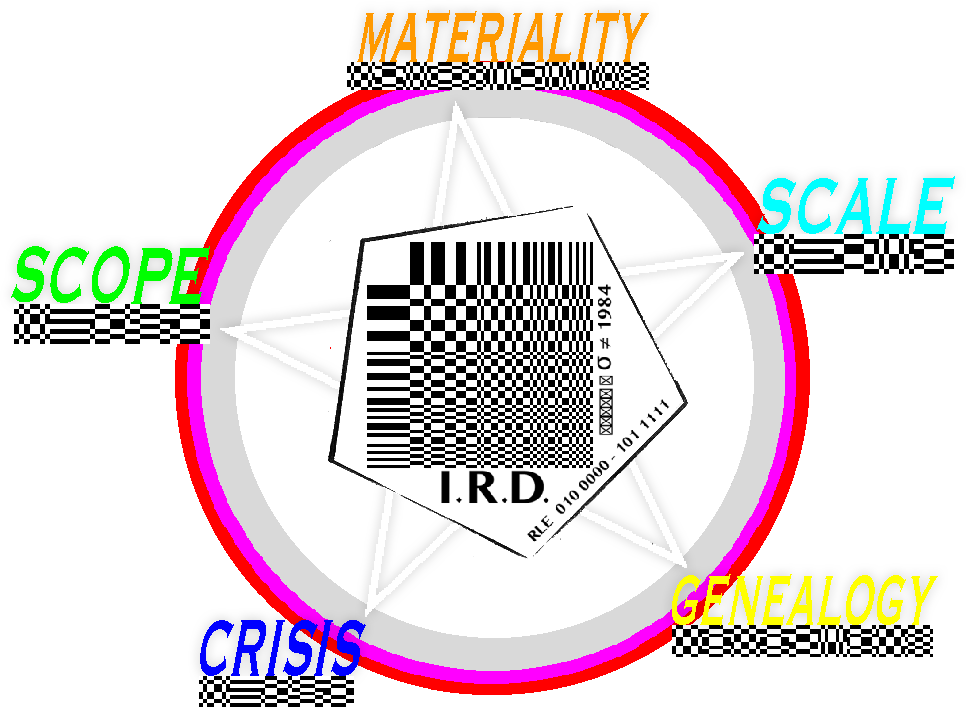SCOPE: (or how habit delineates im/possibility and in/visibility)
Slight changes in scope and scale can uncover an entirely new render ecology
WRITTEN (THEORY)
>>> Jodi op de Pijnbank (2006)
>>> Glitch Studies Manifesto (2009)
>>> Glitch Moment/um (2010)
>>> i.R.D. (2015)
>>> Night of the Unexpected (2016)
>>> Refuse to let the Syntaxes of (a) History Direct our Futures. In: Fragmentation of the Image (2024)
Seminairs of my Resolution class (KHK)
>> Glitch art
>> Tactical Media
>> Anti Instutional queering
>> Media Archeology of the screen / Desktop Documentary
ARTWORKS (PRACTICE)
>>> i.R.D. (2015)
>>> Where are the newer media? (2016)
>>> Realities Beyond Resolution(2013)
>>> Compress Process (2012)
>>> Xilitla (2012 - 2014)
Curated
>>> GLI.TC/H (2010 - 2112)
>>> Quadriptich of curation (2010 - 2014)
Crucially, habit is always something you learn from others, or in response to the environment. […] I understand habit as the scar of others within the self.”
- Chun, Wendy. Characters in a Drama called Big Data, in: Sonic Acts. Noise of Being Reader, 2017. p 114.
Following the ideal logic of transparent immediacy, technology is designed in such a way that the user will forget about the presence of the medium. Generally, technology aims to offer an uninterrupted flow of functionality and information. This concept of flow is not just a trait of the machine, but also a feature of society as a whole, writes DeLanda.1 DeLanda distinguishes between chaotic disconnected flows and stable flows of matter, that move in continuous variations, conveying singularities. DeLanda also references Deleuze and Guattari, who describe flow in terms of the beliefs and desires that both stimulate and maintain society.2 Deleuze and Guattari write that a flow is something that comes into existence over long periods of time. Within these periods, conventions, customs and individual habits are established, while deviations tend to become rare occurrences and are often (mis)understood as accidents (or in computation: glitches). Although the meaningfulness of every day life might in fact be disclosed within these rare occurances, their impact or relevance is often ruled out, because of social tendencies to emphasize the norm.
To move beyond resolution also means to move beyond the habitual. One way to do this is by creating noise, for instance in the form of glitch: a short lived fault or break from an expected flow of operation within a (digital) system. The glitch is a puzzling, difficult to define and enchanting noise artifact; it reveals itself as accident, chaos or laceration and gives a glimpse into normally obfuscated machine language. Rather than creating the illusion of a transparent, well-working interface to information, the glitch can impose both technological and perceptual challenges to habitual and ideological conventions. It shows the machine revealing itself. Suddenly, the computer appears unconventionally deep, in contrast to the more banal, predictable, surface-level behaviors of ‘normal’ machines and systems.
To really understand the complexity of the user’s perceptual experience it is important to focus on these rare occurances - to create an awareness of the users habits by use of, for instance, the accident.
In the 1970s Joseph Goguen and Rod Burstall wrote that ‘institution’ refers to a slightly more compound framework, that deals with the growing complexities, connecting different logical systems (such as databases and programming languages) within computer sciences. A main result of these non-logical institutions is that different logical systems can be glued together at a substrata level, forming illogical frameworks through which computation also takes place.
▁∣∖▁╱◝◟.❘╱▔▔╲̸/╲╱▔▔▔╲∣∖╱▔╲▁▁∣∖▁╱◝◟.╱▔▔╲________
1. Manuel DeLanda, War in the Age of Intelligent Machines, New York: Zone Books, 1991. p. 20.
2. Gilles Deleuze and Pierre-Félix Guattari, A Thousand Plateaus: Capitalism and Schizophrenia, Trans. B. Massumi, Londen: The Athlone Press, 1988. p. 219.








